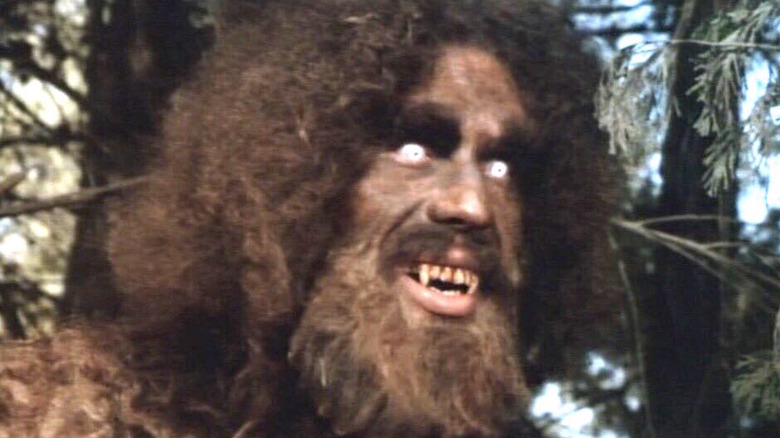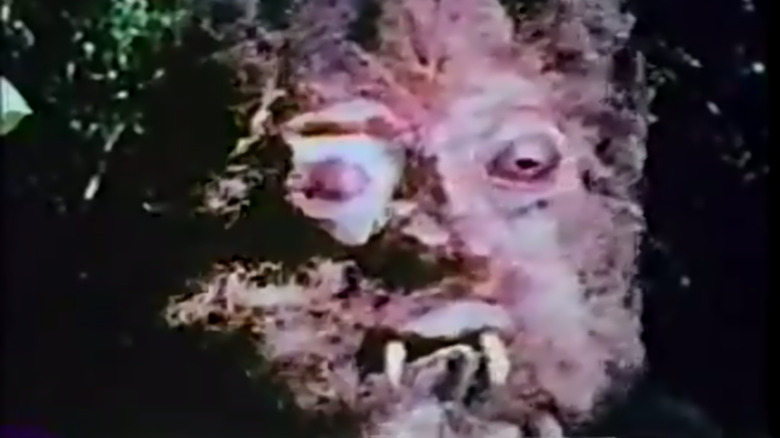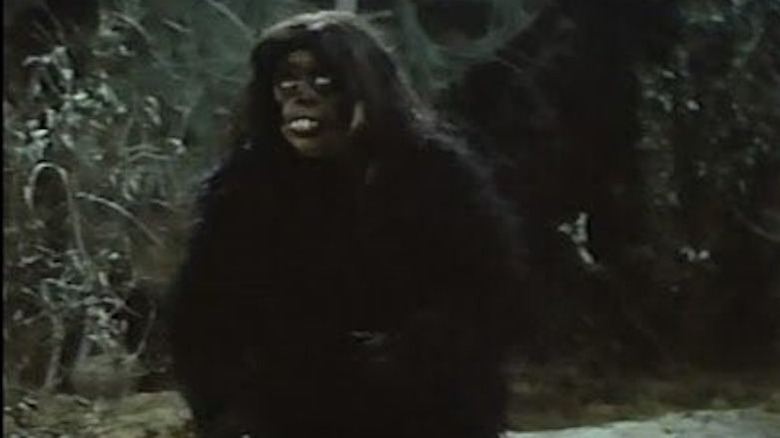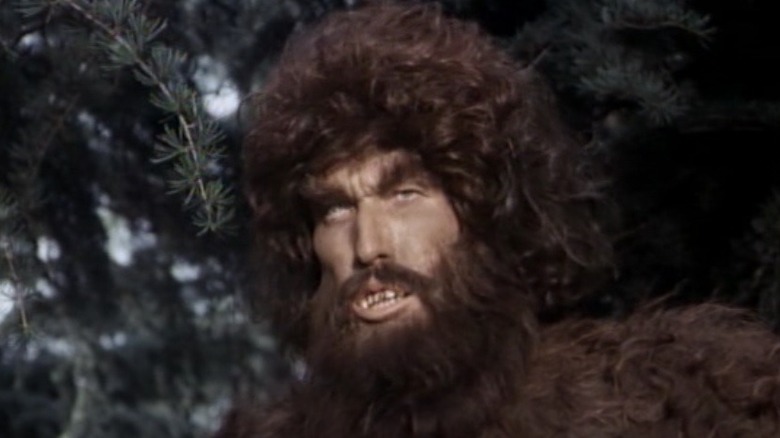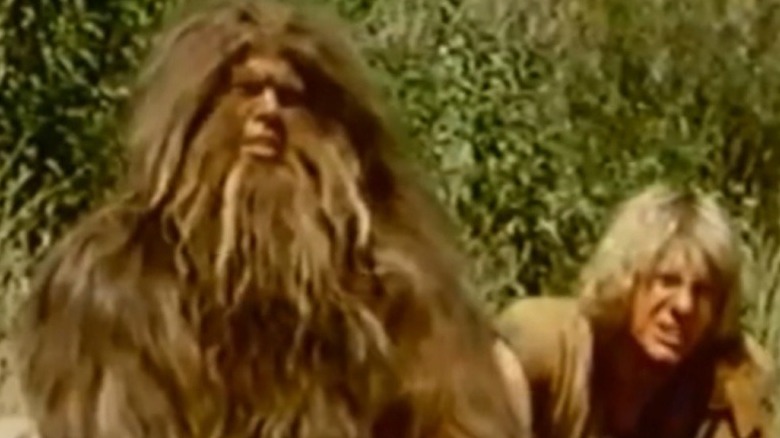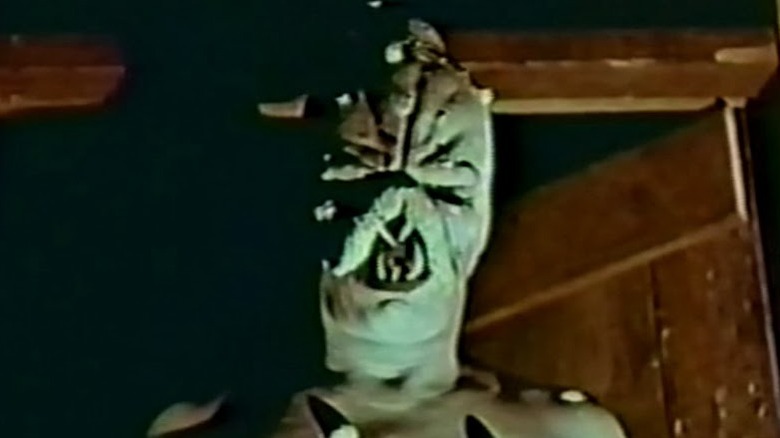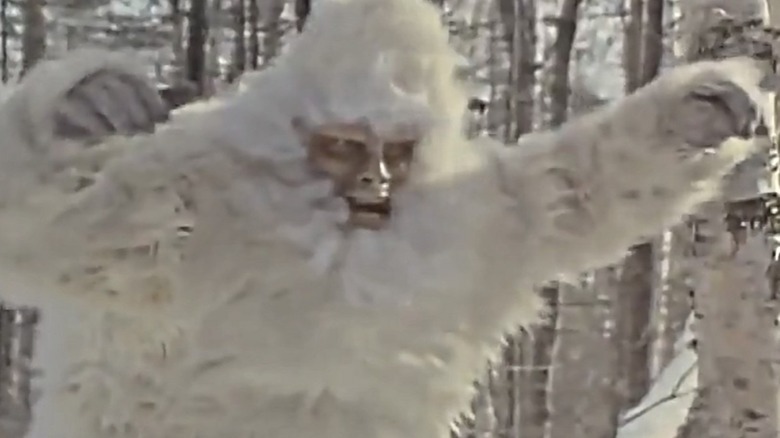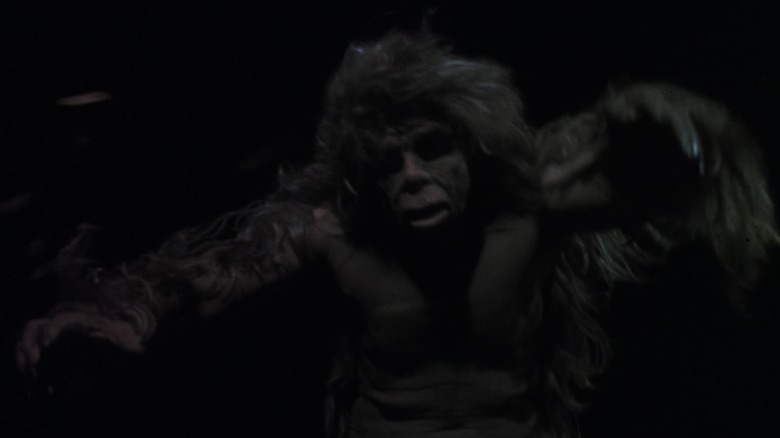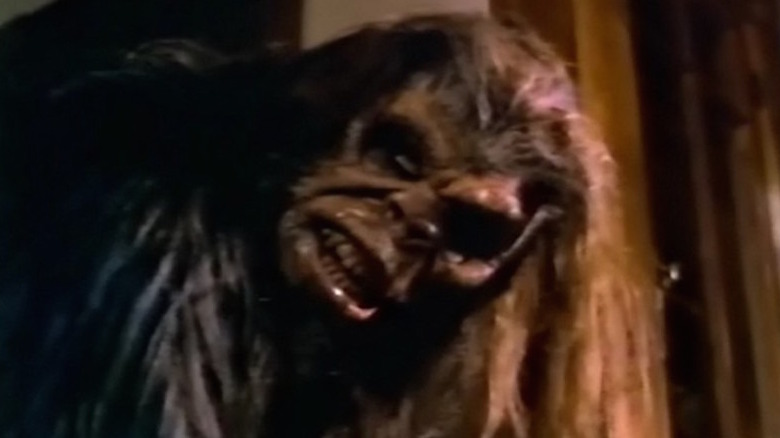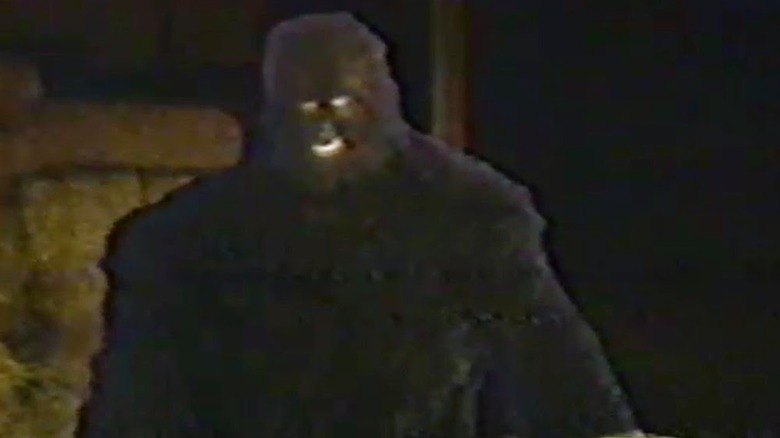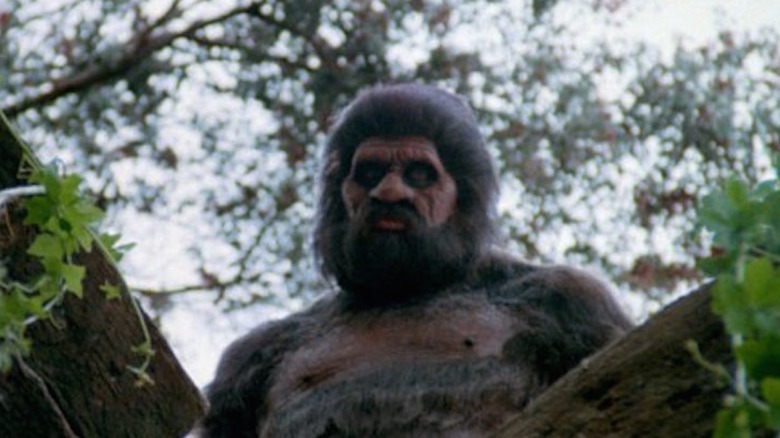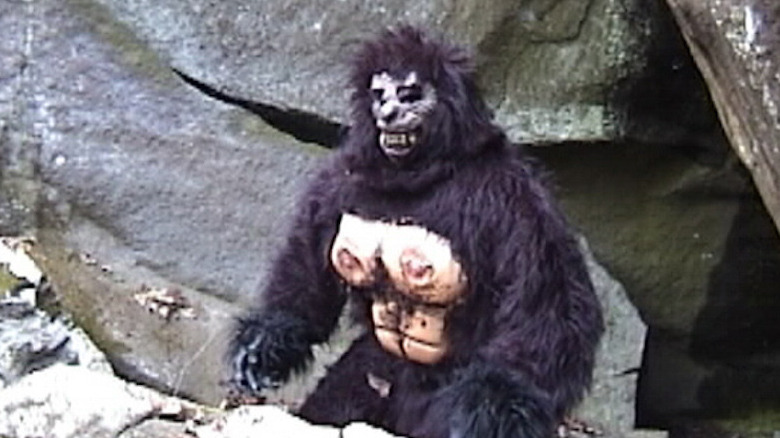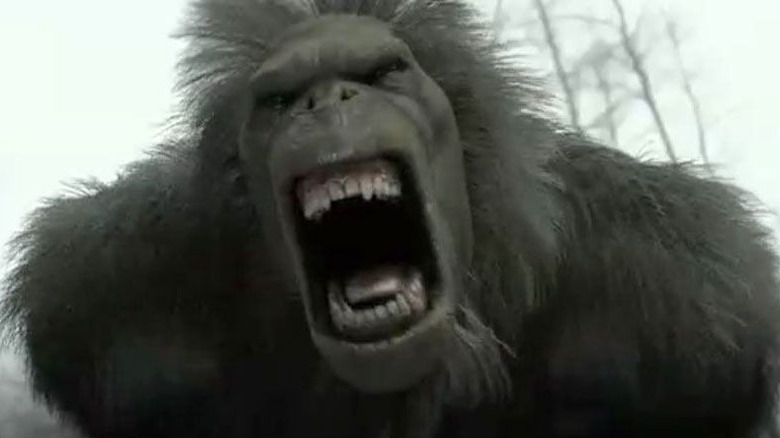The Most Ridiculous Sasquatch Seen In Films And On TV
Why does the cryptid Bigfoot continue to capture the imagination of filmmakers? It's possible that the attraction is based on what Bigfoot represents to modern culture: the solution to a long-standing mystery, the revelation of a hidden chapter in our own evolution from apes to humanity, and the expansion of our scientific knowledge into areas long relegated to myth and legend. Bigfoot suggests that there are riddles we still need to solve, adventures we need to tackle, and fears and dreams we need to comprehend.
On the other hand, Bigfoot also represents a really cheap, easy way to make a monster movie with a built-in pop culture following. Since no definitive image of Bigfoot exists, any depiction of the creature is at least nominally acceptable. Would-be filmmakers can simply rent out a gorilla suit, pay a friend a few bucks to run around in the woods, roll camera, and after a few hours with editing software, have a bona fide horror/fantasy film that's guaranteed to attract at least a few curious viewers.
Needless to say, some of those efforts have produced some silly-looking Sasquatches. For every impressive apeman in films like "Harry and the Hendersons" or "Abominable," there are at least twice as many ratty-looking creatures that barely conceal the perspiring actor inside them. Below is a spoiler-heavy list of the most ridiculous Bigfoots ever glimpsed in films and on TV.
Curse of Bigfoot is two backyard horror movies in one
When is a Bigfoot movie not a Bigfoot movie? When it's an amateur horror production about a Native American mummy that's been awkwardly shoehorned into another (equally amateurish) fright flick and passed off as a Bigfoot picture. Such is the case with "Curse of Bigfoot," a 1975 film by writer-director siblings James and Dave Flocker, who took their 1958 backyard project "Teenagers Battle the Thing" and used it – in its entirety – as a flashback sequence for the new project (for which they're billed as David and James Fields).
All of which sounds like a smart and economical recycling of old material — except for the fact that the "Thing" isn't Bigfoot. It's an ancient indigenous mummy — granted, it looks more like a bear created by industrious if imaginative elementary school students — and only referred to as Bigfoot in wraparound segments that set up "Teenagers" as a flashback to a long-ago archaeological dig which freed the creature to wreak very slow, ineffective havoc on a small town.
A great deal of the film's running time that isn't devoted to the mummy/Bigfoot's rampage is taken up by an almost meditative consideration of everyday objects: discussions of citrus groves and soda pop, footage of loggers cutting down trees, endless mentions of prayer sticks, and the like. The intense inner focus of the script may not give you the shivers, but it might lower your blood pressure.
1970's Bigfoot features some sexist apemen
Writer-director Robert F. Slatzer, whose primary bullet point in the pop culture annals focuses on his alleged three-day marriage to Marilyn Monroe, also directed the grotty 1970 feature "Bigfoot," which seems inordinately fixated on Bigfoot's amorous activities, and which is at least several different kinds of icky, all at once. There's actually three Sasquatch in the film — two small siblings (one played by "Wizard of Oz" actor Jerry Maren) and a colossal father figure — but all three appear to have their minds in the gutter 24-7, given their predilection for kidnapping women and taking them back to their cruddy lair.
Nothing unseemly ever happens onscreen to female stars Joi Lansing (a frequent B-movie actress who turned up briefly in Orson Welles' "Touch of Evil") and Judith Jordan (who went on to do a lot of episodic TV), and they're eventually saved from the Bigfoots' grubby scheme. One would think that male leads Chris and John Mitchum (sons of Hollywood legend Robert Mitchum) and cult favorite John Carradine (who slices off sizable chunks of ham in his performance) pull off the rescue, but those nitwits bungle the job; Carradine wants Father Bigfoot for his traveling carnival, who promptly breaks free and tears up a small town, so the day is largely saved by a passel of grimy bikers and a proactive bear.
Andre the Giant and Ted Cassidy played android Sasquatch on Six Million Dollar Man
Fans of '70s science fiction TV may recall that Bigfoot appeared in not one but five episodes of "The Six Million Dollar Man" and "The Bionic Woman" between 1976 and 1977. His appearances on the series were popular enough to warrant a doll likeness by Kenner Toys called "Bionic Bigfoot," which served as a spoiler of sorts for the series' take on the monster. As the toy Bigfoot showed, what Steve Austin and Jamie Sommers battled on their respective series was no lost evolutionary link to early man, but an alien augmented with futuristic bionics by space scientist Stefanie Powers ("Hart to Hart").
As enjoyable as the idea of the Bionic Man and Woman throwing down against Sasquatch is, the two actors that played the android apeman further cemented the episodes' placement in pop culture history. Wrestling legend and "Princess Bride" star Andre the Giant donned the furry costume for the Season 3 "Six Million Dollar Man" two-parter "The Secret of Bigfoot." As if that weren't enough to provide ample trivia for your next cocktail party, in Season 4's "The Return of Bigfoot" — which concluded in a Season 2 episode of "Bionic Woman" — and Season 5's "Bigfoot V," Ted Cassidy, the original Lurch on "The Addams Family," stepped into the (literal) monkey suit, which also sported a perm that perhaps suggested a link between Sasquatch and Barry Gibb.
"Secret of Bigfoot Part II" also featured a glimpse of the "Doomed Glacier Expedition" attraction at Universal Studios. A rotating tunnel through which visitors passed as part of the studio tour, the attraction doubled as the pathway to Bigfoot and the aliens' underground laboratory.
Bigfoot and Wildboy gave us the Saturday morning Sasquatch
Though "The Six Million Dollar Man" offered primetime stardom to Bigfoot, the creature also became a Saturday morning TV star courtesy of "Bigfoot and Wildboy." Initially a segment on "The Krofft Supershow," a weekly live-action comedy/fantasy show created by Joe Ruby and Ken Spears ("Scooby-Doo") and produced by Sid and Marty Krofft of "H.R. Pufnstuf" fame, "Bigfoot" featured Ray Young as a distinctly hippie-like Sasquatch and Joseph Butcher as his human sidekick. The pair's adventures initially aired as 15-minute segments during the short run of "Supershow" before ABC revived the title in 1979 as a half-hour program built from stitched together older episodes and new material.
Each episode offered a new threat to Bigfoot and Wildboy's stewardship of their unnamed forest home (played by Malibu Creek State Park and Bronson Caves, among other locations): vampires, mummies, aliens, a mutant played by Carel Struckyen from the "Addams Family" feature, Amazons (which count Dee Wallace of "E.T' among their number), and Richard Moll of "Night Court" as a member of a prehistoric tribe. Their face-offs appeared to acknowledge the popularity of the "Six Million Dollar Man" episodes by frequent use of slow-motion footage and numerous slo-mo shots of Bigfoot leaping in the air. Guest stars included Christopher Knight from "The Brady Bunch," Sorrell Booke from "The Dukes of Hazzard," and soap star Steve Bond.
Blood Beast of Monster Mountain pulls a Bigfoot bait and switch
When is a Bigfoot movie not a Bigfoot movie, Part II: 1975's "Blood Beast of Monster Mountain" is the unquestionably enticing new title for a patch-and-stitch job performed by Southern-based producer/distributor and former spook show operator Donn Davison on 1965's "Legend of McCullough's Mountain," a harmless horror-comedy lensed in Atlanta, Georgia. Also known as "The Legend of Blood Mountain" and "Demon Hunter," the film starred George Ellis, who hosted a late-night horror movie showcase on Atlanta TV.
Ellis's on-screen persona, a nitwit named Bestoink Dooley, is the hero of "Mountain," and spends much of his time in the film eating cookies and taking a nap (which produces some alarming dreams involving women in nightwear) before encountering a pale, mean-faced creature which can be charitably described as having considerable junk in its trunk — but not as Bigfoot.
What does this have to do with Bigfoot? Well, Davison saw dollar signs in the wave of Bigfoot pictures in the '70s and filmed several wraparound segments in which he pretends to conduct interviews about Sasquatch, which he then tacked on to the full running time of "Mountain." Instant Bigfoot movie — just add unrelated footage.
In addition to his TV horror host duties, Ellis also acted in other Southern-made films, including 1975's "Moonrunners," which later served as the inspiration for "The Dukes of Hazzard." The corrupt town official played by Ellis was the prototype for Sorrell Booke's Boss Hogg.
Sasquatch gets the shivers in Capture of Bigfoot
Director/co-writer Bill Rebane — the party responsible for such assaults on viewers' sanity as "The Giant Spider Invasion" — applies his unique cinematic approach to huge hominids in 1979's "The Capture of Bigfoot." Like all of Rebane's pictures, "Bigfoot" was lensed in Wisconsin, and takes place during what looks like a particularly harsh winter. That angle gives "Bigfoot" something of a distinction from others of its ilk, as does its primary creatures: a giant white 'Foot called The Legendary Creature of Arak, and its somewhat smaller offspring.
The presence of parent and offspring creatures in a monster movie essentially telegraphs that the primary plot of the movie will borrow from the "Gorgo" template and introduce an unscrupulous type who kidnaps the kid Sasquatch for display, prompting the parent to wreak havoc while looking for its little one. The jerk in question here is Richard Kennedy, who sends Janus Raudkivi — as the bigger Bigfoot — on a skier-slaying, snowmobile-smashing rampage.
The berserk Bigfoot sequences are the main reason to check out "Capture of Bigfoot," though the presence of the great character actor George "Buck" Flower (from "They Live" and "Back to the Future") is an additional selling point. There's also a town sheriff (Wally Flaherty) who won't stop imitating Humphrey Bogart and an extended disco sequence, which may also work for select demographics.
Bigfoot goes for the grossout in Night of the Demon
"Bigfoot's not playing games anymore," says Professor Nugent (Michael Cutt) in "Night of the Demon," and judging by the sheer number of gross, over-the-top kills in this 1980 indie feature, that might be an understatement. The premise of the film — which involves Cutt's dense anthropology professor leading a team of students into a forest area where a Sasquatch has committed several murders — is essentially a framing device for a sort of anthology/greatest-hits package of Horrible and Outrageous Ways to Die at the Hands of Bigfoot.
Former adult film director James C. Wasson gifts viewers with the sight of a ratty-looking apeman whacking someone with an axe, bundling up a camper in his sleeping bag and flinging it against a tree, overpowering a pair of knife-wielding Girl Scouts (!), and conducting a WWE-style assault on the students' cabin, complete with faces shoved onto hot stoves and disembowelment. There's also a very graphic depiction of the dangers inherent to relieving yourself in the woods.
The slaughter spree in "Night of the Demon" is more than enough gore for at least three low-budget horror movies — which earned it a spot in the UK's notorious Video Nasties controversy in the 1980s — but Wasson and writer Mike Williams also bundle the splatter with a subplot involving a deranged preacher, his much-abused daughter, their involvement in a Satanic cult, and Bigfoot's amorous encounters with said daughter, which result in a half-human Bigfoot baby. Taste-free from start to finish, "Night of the Demon" is the Bigfoot movie for fans who like their Sasquatch on the sleazy side.
In Demonwarp, Bigfoot is the least of your worries
There's a Bigfoot on hand in 1988's "Demonwarp," but it's just one of the budget-minded monsters on hand to menace Oscar winner George Kennedy and a cast of actors playing knuckleheaded teens. Special effects makeup designer John Carl Buechler, whose FX credits include "Troll," "Re-Animator," and entries in the "Nightmare on Elm Street," "Friday the 13th," and "Halloween" franchises, is credited with penning the story for "Demonwarp," which aims for ambitious and imaginative but lands somewhere between disjointed and "please explain what's going on here."
Suffice it to say that the Bigfoot on hand in "Demonwarp" may be in the employment of aliens, which land in a remote area in the 19th century with designs on world domination. A small cadre of zombies also fits into their scheme, which proves remarkably successful at decimating a number of hormonally-supercharged teens in a nearby cabin. Thankfully, Kennedy's shotgun-wielding old coot — whose daughter fell victim to Bigfoot — has monster-bashing in mind. Kennedy's daughter, Shannon, also appears alongside '80s scream queen Michelle Bauer as a pair of girls on the hunt for free marijuana who become entangled in the story.
There's horseback riding, camping, and Bigfoot in Black River Monster
Lensed entirely at Michigan's Black River Farm and Ranch ("an operating summer horse ranch for girls," as a title card notes), 1986's "Black River Monster" concerns the collision of Leroy, a terminally lazy ranch hand (Craig Martin), and a Bigfoot that resembles an enormous bear one might win at a carnival. Leroy gets hassled by virtually everyone he encounters on screen, while Bigfoot spends much of his screen time in pursuit of gentle fun — petting baby farm animals and the like. Eventually, the pair crosses paths, and Bigfoot lends Leroy a hand by throttling his two primary antagonists, one of whom is a feral-looking gent named Sleaze.
Clocking in at less than an hour's running time, "Black River Monster" is essentially a promotional video for Black River Farm, which seems like a nice place (and remains active). The tone is broadly comic — much of the humor anchors around Martin's ability to pull off pratfalls and dress in drag to play his own mother — and the monster is charming in a threadbare way. It's unclear if "Black River Monster" attracted much attention at Black River Farm and Ranch, but one imagines that kids who attended the camp while the film was being shot — and who appear in the picture — occasionally wonder to themselves, "Was I in a Bigfoot movie at horseback camp, or did I imagine that?"
Have a Coke and a Sasquatch with Cry Wilderness
Low-budget filmmakers have three paths to take with a Bigfoot project: a speculative documentary like 1975's "The Mysterious Monsters," which features plenty of grainy re-enactments; a straight-up horror movie (like any of the other films on this list); or a family adventure which imagines that the hairy, elusive creature is more than happy to befriend families, grizzled mountain men — or, in the case of 1987's "Cry Wilderness," lonely and confused teenagers.
Eric Foster, who plays the oddball kid in "Wilderness," is confused because no one at his private school believes that he made nice with a (oddly well-groomed) Sasquatch over pop tunes and Coca-Cola (which merits many mentions in the film). But the script by Oscar-winning writer Philip Yordan — whose credits include classic Hollywood films like "Johnny Guitar" and "The Big Combo" — quickly pushes that element into the wings in favor of a storyline involving the pursuit of an escaped tiger by Paul's clueless forest ranger dad and a big game hunter with designs on Bigfoot.
There's a lot going on in "Cry Wilderness," but precious little of it makes sense. The filmmakers — who were also responsible for the equally incomprehensible horror anthology "Night Train to Terror" — attempt to close gaps in the plot logic with copious amounts of stock footage, but they only seem to make matters worse.
Meet your new neighbor: Suburban Sasquatch
Numerous news reports have noted that development expansion and other factors have spurred many wild species to move into heavily populated areas, so it only makes sense that the wildest of them all — Bigfoot — would follow suit and become a new resident in the suburbs. However, as the 2004 indie "Suburban Sasquatch" explains, Bigfoot does not abide by the good neighbor policy: the creature carries out a number of bloody murders — aided in no small part by its ability to teleport — until a hapless reporter and a Native American hunt it down.
"Suburban Sasquatch" was filmed with a microscopic budget in West Chester, Pennsylvania by one-man-band Dave Wascavage, who wrote, directed, produced, photographed, edited, and scored the film in addition to playing five roles (including Bigfoot) and cast what appears to be most of his family in supporting roles. The tone is mostly tongue-in-cheek — a notion borne out by its monster, a ratty ape suit with curiously prodigious pecs — which makes the atrocious special effects and performances slightly more palatable.
A Sasquatch battles Bradys and Partridges in Bigfoot
A joint effort between mockbuster specialists The Asylum and Syfy, 2012's "Bigfoot" offers viewers the (hopefully) once-in-a-lifetime sight of former '70s kid stars Danny Bonaduce and Greg Williams fighting a CGI ape monster on top of Mount Rushmore. As that sentence clearly indicates, "Bigfoot" is a goof that plays to audience nostalgia for its cast — which includes Sherilyn Fenn, Alice Cooper, Howard Hesseman, and Oscar nominee Bruce Davison, who also directed — and the guilty pleasure of "bad movies."
"Bigfoot" is a notch or two above most Asylum and Syfy efforts — Bonaduce and Williams are amusing as broadly comic versions of themselves, and Davison spares no quarter in depicting the gory side of Bigfoot, even if the creature's size tends to vary from scene to scene. While it lacks the kitchen-sink gonzo attitude of the "Sharknado" series — not necessarily a bad thing — "Bigfoot" hits enough marks to please those with an appetite for movie cheese.
